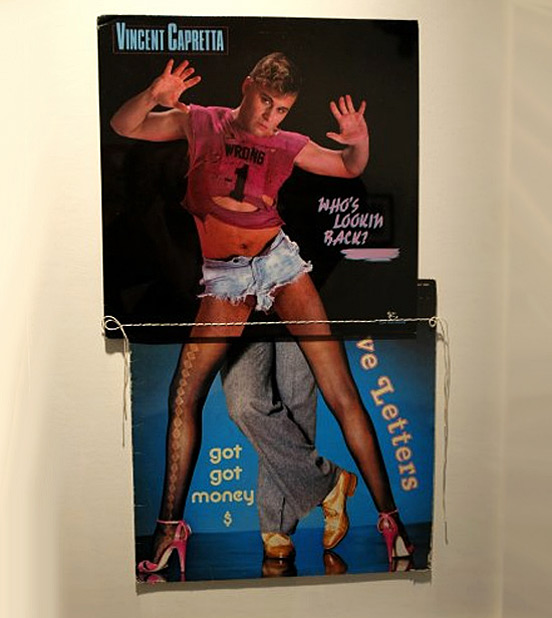Another clever art form is coming, that is album cover art. The visual pioneer is Christian Marclay. As for Marclay, I think most of us know him because of his music. Right, he is a famous DJ and composer who firstly uses gramaphone records and turntables as musical instruments to create sound collage. While besides, he likes collecting record covers of Michael Jackson, Doors, Donna Summer, David Bowie and many others to re-join new pieces. Christian Marclay might just take Bowie and put him together with MJ or the Black Eyed Peas. No sexism from his side, ladies are caught up in the mix as well. The following are some work from him. I’m they will give a fresh visual effect.
source: thedesigninspiration.com
Christian Marclay (b. 11 January 1955, San Rafael, California, USA) is a Swiss-American visual artist and composer.
Marclay's work explores connections between sound, noise, photography, video, and film. A pioneer of using gramophone records and turntables as musical instruments to create sound collages, Marclay is, in the words of critic Thom Jurek, perhaps the "unwitting inventor of turntablism."[1] His own use of turntables and records, beginning in the late 1970s, was developed independently of but roughly parallel to hip hop's use of the instrument.[2]
Biography
Christian Marclay was born on 11 January 1955 in San Rafael, Marin County, California to a Swiss father and an American mother (maiden name Frese) and raised in Geneva, Switzerland.[3][4][2][5] He studied at the Ecole Supérieure d'Art Visuel in Geneva (1975–1977), the Massachusetts College of Art in Boston (1977–1980, Bachelor of Fine Arts), and the Cooper Union in New York (1978).[2][6] As a student he was notably interested in Joseph Beuys and the Fluxus movement of the 1960s and 1970s.[7] Long based in Manhattan, Marclay has in recent years divided his time between New York and London.[8]Drawn to the energy of punk rock, Marclay began creating songs, singing to music on pre-recorded backing tapes. Unable to recruit a drummer for his 1979 performances with guitarist Kurt Henry, Marclay used the regular rhythms of a skipping LP record as a percussion instrument.[9] These duos with Henry might be the first time a musician used records and turntables as interactive, improvising musical instruments.[10]
Marclay sometimes manipulates or damages records to produce continuous loops and skips,[11] and has said he generally prefers inexpensive used records purchased at thrift shops, as opposed to other turntablists who often seek out specific recordings. In 1998 he claimed never to have paid more than US$1 for a record.[9] Marclay has occasionally cut and re-joined different LP records; when played on a turntable, these re-assembled records will combine snippets of different music in quick succession along with clicks or pops from the seams[12] – typical of noise music – and when the original LPs were made of differently-colored vinyl, the reassembled LPs can themselves be objets d'art.
Some of Marclay's musical pieces are carefully recorded and edited plunderphonics-style; he is also active in free improvisation. He was filmed performing a duo with Erikm for the documentary Scratch. His scene didn't make the final cut, but is included among the DVD extras.
Thom Jurek writes that "While many intellectuals have made wild pronouncements about Marclay and his art – and it is art, make no mistake – writing all sorts of blather about how he strips the adult century bare by his cutting up of vinyl records and pasting them together with parts from other vinyl records, they never seem to mention that these sound collages of his are charming, very human, and quite often intentionally hilarious."[13]
Marclay has performed and recorded both solo and in collaboration with many musicians, including John Zorn, William Hooker, Elliott Sharp, Otomo Yoshihide, Butch Morris, Shelley Hirsch, Flo Kaufmann and Crevice; he has also performed with the group Sonic Youth, and in other projects with Sonic Youth's members.
At the 2011 Venice Biennale, Marclay was recognised as the best artist in the official exhibition, winning the Golden Lion for The Clock, a 24-hour compilation of time-related scenes from movies that debuted at London's White Cube gallery in 2010. Newsweek responded by naming Marclay one of the ten most important artists of today.[14] Accepting the Golden Lion, Marclay invoked Andy Warhol, thanking the jury "for giving The Clock its fifteen minutes".[15]









